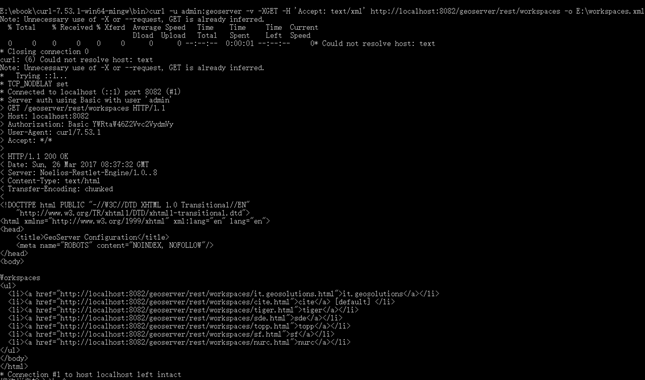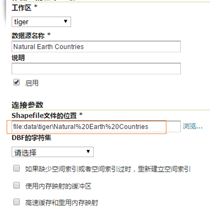1.部署一个简单的测试环境
测试geoserver REST接口,我们可使用python来测试,很方便。需要下载包:
python,http://python.org/。我下载的是Python27版本。
cURL,几个简单的命令行工具,很容易使用命令交互, 地址为http://curl.haxx.se/download.html,下载curl-7.53.1-win64-mingw版本。
Requests,一个给phtyon提供REST支持的插件,https://github.com/kennethreitz/requests。
三个包现在后,配置python的环境变量。打开Requests下载后的目录。在该目录下执行以下命令:
python setup.py install
~$ python
>>> import requests
2.使用curl获取工作区列表
解压curl下载包,进入目录“curl-7.53.1-win64-mingw\bin”,执行cmd命令。输入以下命令:
curl -u admin:geoserver -v -XGET -H 'Accept: text/xml' http://localhost:8082/geoserver/rest/workspaces -o E:\workspaces.xml
参数说明: -u表示验证的用户名和密码,-v表示输入版本, -X表示请求的方式,-H表示输入的请求头信息,-o打印输出文件。但实际不知道-o文件输出到哪里去了,没找到。 输出结果如下:
打开用于输出的一个目录,在该目录下执行cmd指令。分别一步一步执行以下python指令:
python import requests myUrl = 'http://localhost:8082/geoserver/rest/workspaces' headers = {'Accept': 'text/xml'} resp = requests.get(myUrl,auth=('admin','geoserver'),headers=headers) resp.status_code file = open('workspaces_py.xml','w') file.write(resp.text) file.close()
打开workspaces_py.xml文件查看输出结果。额curl输出结果一样。
4.查看工作区下的数据存储
指令和3相似,myUrl有点区别:myUrl = ‘http://localhost:8082/geoserver/rest/workspaces/tiger’。查询结果:
<workspace> <name>tiger</name> <dataStores> <atom:link xmlns:atom="http://www.w3.org/2005/Atom" rel="alternate" href="http://localhost:8082/geoserver/rest/workspaces/tiger/datastores.xml" type="application/xml"/> </dataStores> <coverageStores> <atom:link xmlns:atom="http://www.w3.org/2005/Atom" rel="alternate" href="http://localhost:8082/geoserver/rest/workspaces/tiger/coveragestores.xml" type="application/xml"/> </coverageStores> <wmsStores> <atom:link xmlns:atom="http://www.w3.org/2005/Atom" rel="alternate" href="http://localhost:8082/geoserver/rest/workspaces/tiger/wmsstores.xml" type="application/xml"/> </wmsStores> </workspace>
5.查询命名空间
查询命名空间列表url:http://localhost:8082/geoserver/rest/namespaces。
查询某个具体的命名空间url:http://localhost:8080/geoserver/rest/namespaces/tiger。
6.创建命名空间
使用curl创建,指令如下:
curl -u admin:geoserver -XPOST -H 'Content-type: text/xml' -d '<namespace><prefix>newWorkspace</prefix><uri>http://geoserver.org</uri></namespace>' http://localhost:8082/geoserver/rest/namespaces
使用python创建,指令如下:
>>> myUrl = 'http://localhost:8082/geoserver/rest/namespaces'
>>> file = open('requestBody.xml','r')
>>> payload = file.read()
>>> headers = {'Content-type': 'text/xml'}
>>> resp = requests.post(myUrl, auth=('admin','geoserver'),data=payload, headers=headers)
>>> resp.status_code
requestBody.xml内容:
<namespace><prefix>newWorkspace</prefix><uri>http://geoserver.org</uri></namespace>
7.修改命名空间
使用python指令如下:
>>> myUrl = 'http://localhost:8082/geoserver/rest/namespaces/newWorkspace'
>>> file = open('requestBody.xml','r')
>>> payload = file.read()
>>> headers = {'Content-type': 'text/xml'}
>>> resp = requests.put(myUrl,auth=('admin','geoserver'),data=payload, headers=headers)
requestBody.xml内容:
<namespace><prefix>newWorkspace</prefix><uri>http://localhost:8082/geoserver</uri></namespace>
8.删除命名空间
使用python指令如下:
>>> myUrl = 'http://localhost:8082/geoserver/rest/workspaces/newWorkspace'
>>> headers = {'Accept': 'text/xml'}
>>> resp = requests.delete(myUrl, auth=('admin','geoserver'),headers=headers)
>>> resp.status_code
9.获取数据存储列表
使用python指令如下:
>>> myUrl = 'http://localhost:8082/geoserver/rest/workspaces/tiger/datastores'
>>> headers = {'Accept': 'text/xml'}
>>> resp = requests.get(myUrl,auth=('admin','geoserver'),headers=headers)
>>> file = open('tiger_datastores.xml','w')
>>> file.write(resp.text)
>>> file.close()
输出的tiger_datastores.xml内容如下:
<dataStores> <dataStore> <name>50m-rivers-lake-centerlines</name> <atom:link xmlns:atom="http://www.w3.org/2005/Atom" rel="alternate" href="http://localhost:8082/geoserver/rest/workspaces/tiger/datastores/50m-rivers-lake-centerlines.xml" type="application/xml"/> </dataStore> <dataStore> <name>ne_10m_railroads</name> <atom:link xmlns:atom="http://www.w3.org/2005/Atom" rel="alternate" href="http://localhost:8082/geoserver/rest/workspaces/tiger/datastores/ne_10m_railroads.xml" type="application/xml"/> </dataStore> </dataStores>
10.获取某个存储的具体数据
使用python指令如下:
>>> myUrl = 'http://localhost:8082/geoserver/rest/workspaces/tiger/datastores/ne_50m_populated_places'
>>> headers = {'Accept': 'text/html'}
>>> resp = requests.get(myUrl,auth=('admin','geoserver'),headers=headers)
>>> file = open('tiger_ne_50m_populated_places_datastores.xml','w')
>>> file.write(resp.text)
>>> file.close()
输出结果如下:
<!DOCTYPE html PUBLIC "-//W3C//DTD XHTML 1.0 Transitional//EN" "http://www.w3.org/TR/xhtml1/DTD/xhtml1-transitional.dtd"> <html xmlns="http://www.w3.org/1999/xhtml" xml:lang="en" lang="en"> <head> <title>GeoServer Configuration</title> <meta name="ROBOTS" content="NOINDEX, NOFOLLOW"/> </head> <body> Data Store "ne_50m_populated_places" <ul> <li><a href="http://localhost:8082/geoserver/rest/workspaces/tiger/datastores/ne_50m_populated_places/featuretypes/ne_50m_populated_places.html">ne_50m_populated_places</a></li> </ul> </body> </html>
11.添加数据存储
使用python指令如下:
>>> myUrl = 'http://localhost:8082/geoserver/rest/workspaces/tiger/datastores'
>>> file = open('tigerCounties.xml','r')
>>> payload = file.read()
>>> headers = {'Content-type': 'text/xml','Accept': 'text/xml'}
>>> resp = requests.post(myUrl, auth=('admin','geoserver'),data=payload, headers=headers)
>>> resp.status_code
传递的tigerConties.xml内容如下:
<dataStore> <name>tl_2011_47_concity_REST</name> <description>tiger counties created from REST</description> <!-- 上传数据存储的类型 --> <type>Shapefile</type> <!-- 数据存储是否可用--> <enabled>true</enabled> <connectionParameters> <!-- 使用内存映射的缓冲区 --> <entry key="memory mapped buffer">false</entry> <!-- 如果缺少空间索引或者空间索引过时,重新建立空间索引 --> <entry key="create spatial index">true</entry> <!-- DBF的字符集 --> <entry key="charset">ISO-8859-1</entry> <!-- 数据文件类型 --> <entry key="filetype">shapefile</entry> <!-- 如果缺少空间索引或者空间索引过时,重新建立空间索引 --> <entry key="cache and reuse memory maps">true</entry> <!-- 上传数据文件的路径 --> <entry key="url">E:\ebook\GeoServer_Beginners+Guide\output\tl_2011_47_concity\tl_2011_47_concity.shp</entry> <entry key="namespace">http://www.census.gov</entry> </connectionParameters> <__default>false</__default> </dataStore>
12.修改数据存储
和新增数据存储相似,配置文件tigerCounties.xml修改后。上传该文件,提交使用“PUT”方式。
resp = requests.put(myUrl, auth=('admin','geoserver'),data=payload, headers=headers)
13.删除数据存储
使用python指令如下:
>>> myUrl = 'http://localhost:8082/geoserver/rest/workspaces/tiger/datastores/tl_2011_47_concity_REST'
>>> headers = {'Accept': 'text/xml'}
>>> resp = requests.delete(myUrl, auth=('admin','geoserver'),headers=headers)
14.使用put方式增加shapefile文件
这种方式是直接把shapfile文件上传到geoserver服务器上,所有必须是*.zip包。使用python命令如下:
>>> myUrl = 'http://localhost:8082/geoserver/rest/workspaces/tiger/datastores/Natural+Earth+Countries/file.shp'
>>> file = open('110m-admin-0-countries.zip','rb')
>>> payload = file.read()
>>> headers = {'Content-type': 'application/zip'}
>>> resp = requests.put(myUrl, auth=('admin','geoserver'),data=payload, headers=headers)
“Natural+Earth+Countries”表示数据存储名字为“Natural Earth Countries”;url中的file.shpe是指上传到服务器上存储的shape文件名字;“110m-admin-0-countries.zip”即是需要上传的shape文件压缩包。上传过后,可以在geoserver服务界面查看文件路径:
对应的物理路径在geoserver安装目录下的data目录下。
15.把PostGIS中的一个表添加到一个图层
之前在工作空间cite有创建过一个PostGIS的数据存储,叫做myPostGIS。假如我们已经在PostgreSQL数据库中增加了一个表“ne_110m_admin”,现在我想把表映射到数据存储myPostGIS下的一个图层。
使用python指令如下:
>>> myUrl = 'http://localhost:8082/geoserver/rest/workspaces/cite/datastores/myPostGIS/featuretypes'
>>> payload = '<featureType><name>ne_110m_admin</name></featureType>'
>>> headers = {'Content-type': 'text/xml'}
>>> resp = requests.post(myUrl, auth=('admin','geoserver'),data=payload, headers=headers)
以上命令执行后,可在图层列表总看到一个新的图层“ne_110m_admin”。
如果我们想增加更多的图层配置,例如显示名称“name”、唯一标示名称“nativeName”、keywords包含表字段。如下:
<featureType> <name>World boundaries</name> <nativeName>ne_110m_admin</nativeName> <title>World boundaries</title> <abstract>World administrative boundaries at small scale</abstract> <keywords> <string>Political</string> <string>World</string> </keywords> <featureType>
如果我们想创建一个新表,可以在配置信息中配置表的字段、srs等。例如:
<featureType> <name>rivers</name> <nativeName>rivers</nativeName> <title>World River</title> <srs>EPSG:4326</srs> <attributes> <attribute> <name>geom</name> <binding>com.vividsolutions.jts.geom.Polyline</binding> </attribute> <attribute> <name>name</name> <binding>java.lang.String</binding> <length>30</length> </attribute> <attribute> <name>country_code</name> <binding>java.lang.String</binding> <length>8</length> </attribute> </attributes> </featureType>
16.查询样式
使用python指令如下:
>>> myUrl = 'http://localhost:8082/geoserver/rest/styles/PopulatedPlacesLabeled'
>>> headers = {'Accept: application/vnd.ogc.sld+xml'}
>>> resp = requests.get(myUrl, auth=('admin','geoserver'),headers=headers)
>>> file = open('PopulatedPlacesBlueLabeled.xml','w')
>>> file.write(resp.text)
>>> file.close()
17.新增样式
使用python指令如下:
>>> myUrl = 'http://localhost:8082/geoserver/rest/styles'
>>> file = open('PopulatedPlacesBlueLabeled.xml','r')
>>> payload = file.read()
>>> headers = {'Content-type': 'application/vnd.ogc.sld+xml'}
>>> resp = requests.post(myUrl, auth=('admin','geoserver'),data=payload, headers=headers)
18.所有REST接口查询地址
http://docs.geoserver.org/stable/en/user/rest/api/styles.html#rest-api-styles-post-put
19.查询WFS服务的能力
使用ptyhon指令如下:
myUrl = 'http://localhost:8082/geoserver/wfs?service=wfs&version=1.0.0&request=GetCapabilities' headers = {'Accept': 'text/xml'} resp = requests.get(myUrl,auth=('admin','geoserver'),headers=headers) resp.status_code file = open('getCapabilities.xml','w') file.write(resp.text) file.close()
查看getCapabilities.xml文件,内容比较多,包含了所有的图层信息FeatureType。FeatureType部分内容如下:
<FeatureType> <Name>NaturalEarth:10m_railroads</Name> <Title>10m_railroads</Title> <Abstract/> <Keywords>10m_railroads, features</Keywords> <SRS>EPSG:4326</SRS> <LatLongBoundingBox minx="-150.08159339101002" miny="8.329046942181577" maxx="-59.94810950429127" maxy="64.93097565311908"/> </FeatureType>
20.查询featureType的完整描述
使用python指令如下:
myUrl = "http://localhost:8082/geoserver/wfs? service=wfs&version=1.0.0&request=DescribeFeatureType&TypeName=tiger:tiger_roads" headers = {'Accept': 'text/xml'} resp = requests.get(myUrl,auth=('admin','geoserver'),headers=headers) resp.status_code file = open('tiger_roads.xml','w') file.write(resp.text) file.close()
查看getFeature.xml文件,内容如下:
<?xml version="1.0" encoding="UTF-8"?><xsd:schema xmlns:gml="http://www.opengis.net/gml" xmlns:tiger="http://www.census.gov" xmlns:xsd="http://www.w3.org/2001/XMLSchema" elementFormDefault="qualified" targetNamespace="http://www.census.gov"> <xsd:import namespace="http://www.opengis.net/gml" schemaLocation="http://localhost:8082/geoserver/schemas/gml/2.1.2/feature.xsd"/> <xsd:complexType name="tiger_roadsType"> <xsd:complexContent> <xsd:extension base="gml:AbstractFeatureType"> <xsd:sequence> <xsd:element maxOccurs="1" minOccurs="0" name="the_geom" nillable="true" type="gml:MultiLineStringPropertyType"/> <xsd:element maxOccurs="1" minOccurs="0" name="CFCC" nillable="true" type="xsd:string"/> <xsd:element maxOccurs="1" minOccurs="0" name="NAME" nillable="true" type="xsd:string"/> </xsd:sequence> </xsd:extension> </xsd:complexContent> </xsd:complexType> <xsd:element name="tiger_roads" substitutionGroup="gml:_Feature" type="tiger:tiger_roadsType"/></xsd:schema>
21.查看featureType的数据
使用python指令如下:
myUrl = "http://localhost:8082/geoserver/wfs? service=wfs&version=1.1.0&request=GetFeature&TypeName=tiger:tiger_roads&maxFeatures=1" headers = {'Accept': 'text/xml'} resp = requests.get(myUrl,auth=('admin','geoserver'),headers=headers) resp.status_code file = open('getFeature.xml','w') file.write(resp.text) file.close()
maxFeaturres参数指定参数feature的条数,这里只查询了一条。有时候我们还需要一些额外的空间属性过滤条件。例如可以使用bbox参数设置查询边界。
"http://localhost:8082/geoserver/wfs?service=wfs&version=1.0.0&request=GetFeature&TypeName=tiger_roads&bbox=-116.68,36.29,-111.36,39.90"
返回数据格式如下:
<wfs:FeatureCollection … > <gml:boundedBy> <gml:null>unknown</gml:null> </gml:boundedBy> <gml:featureMember> <NaturalEarth:10m_railroads fid="10m_railroads.481"> <NaturalEarth:the_geom> <gml:MultiLineString srsName="http://www.opengis. net/gml/srs/epsg.xml#4326"> <gml:lineStringMember> <gml:LineString> <gml:coordinates xmlns:gml="http:// www.opengis.net/gml" decimal="." cs="," ts=" ">- 116.86064613,34.86170075 -116.85924232,34.86536286 ... -112.16722572,40.70233796 -112.15178382,40.70752595</gml:coordinates> </gml:LineString> </gml:lineStringMember> </gml:MultiLineString> </NaturalEarth:the_geom> <NaturalEarth:ScaleRank>8</NaturalEarth:ScaleRank> <NaturalEarth:FeatureCla>Railroad</ NaturalEarth:FeatureCla> <NaturalEarth:SOV_A3>USA</NaturalEarth:SOV_A3> <NaturalEarth:UIDENT>49706</NaturalEarth:UIDENT> </NaturalEarth:10m_railroads> </gml:featureMember> </wfs:FeatureCollection>
22.查询WCS服务能力
使用ptyhon指令如下:
myUrl = "http://localhost:8082/geoserver/wcs?service=wcs&version=1.0.0&request=GetCapabilities" headers = {'Accept': 'text/xml'} resp = requests.get(myUrl,auth=('admin','geoserver'),headers=headers) file = open('getCapabilities.xml','w') file.write(resp.text) file.close()
返回结果包含了每个coverage影像的描述信息。nurc:Img_Sample影像的描述信息如下:
<wcs:CoverageOfferingBrief> <wcs:description>A very rough imagery of North America</ wcs:description> <wcs:name>nurc:Img_Sample</wcs:name> <wcs:label>North America sample imagery</wcs:label> <wcs:lonLatEnvelope srsName="urn:ogc:def:crs:OGC:1.3:CRS84"> <gml:pos>-130.85168 20.7052</gml:pos> <gml:pos>-62.0054 54.1141</gml:pos> </wcs:lonLatEnvelope> <wcs:keywords> <wcs:keyword>WCS</wcs:keyword> <wcs:keyword>worldImageSample</wcs:keyword> <wcs:keyword>worldImageSample_Coverage</wcs:keyword> </wcs:keywords> </wcs:CoverageOfferingBrief>
23.查询WCS某个图层的详细描述
使用python指令如下:
myUrl ="http://localhost:8082/geoserver/wcs? service=wcs&version=1.0.0&request=DescribeCoverage&Coverage=nurc:Img_Sample" headers = {'Accept': 'image/tiff'} resp = requests.get(myUrl,auth=('admin','geoserver'),headers=headers) file = open('describeCoverage.xml','w') file.write(resp.text) file.close()
返回结果包含了该图层的详细描述。
24.查看WCS图层的数据
查询影响图层数据,必须传递bbox、width以及height参数。使用python指如下:
myUrl = "http://localhost:8082/geoserver/wcs? service=wcs&version=1.0.0&request=GetCoverage&coverage=nurc:Img_Sample&crs=EPSG:4326&bbox=- 130.85168,20.7052,-62.0054,54.1141&width=982&height=597&format=geotiff&bands=1" headers = {'Accept': 'text/xml'} resp = requests.get(myUrl,auth=('admin','geoserver'),headers=headers) file = open('coverage.tiff','w') file.write(resp.text) file.close()
查询结果返回一个tiff格式的图片文件。





